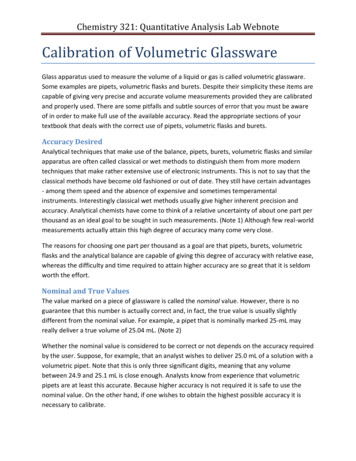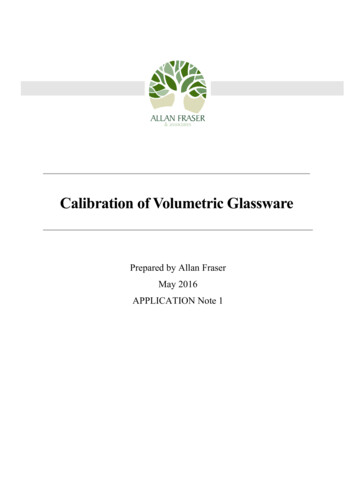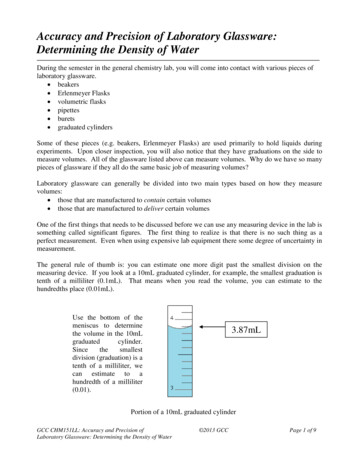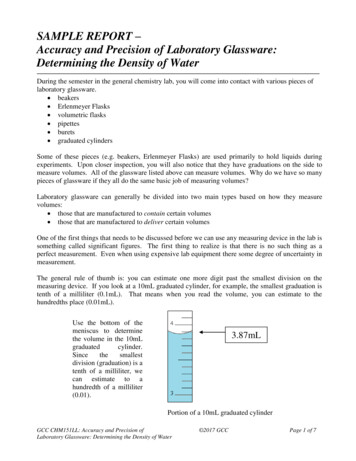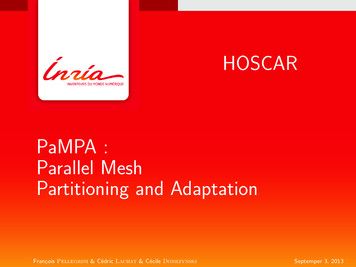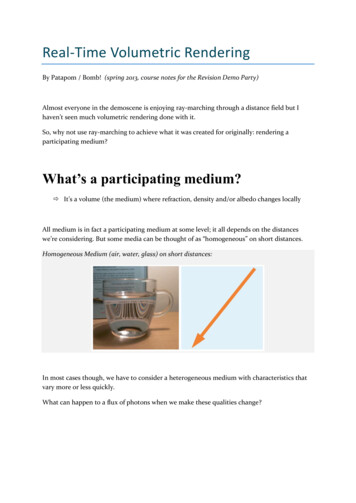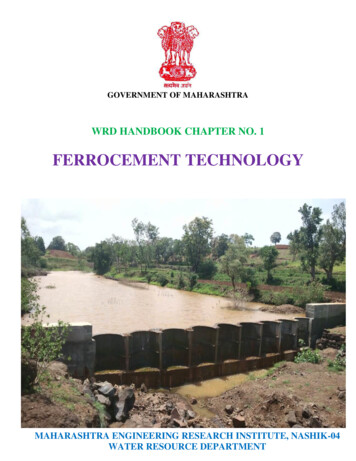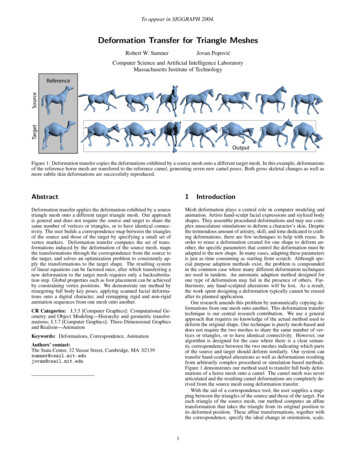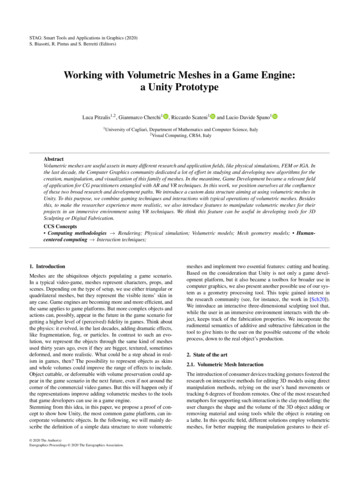
Transcription
STAG: Smart Tools and Applications in Graphics (2020)S. Biasotti, R. Pintus and S. Berretti (Editors)Working with Volumetric Meshes in a Game Engine:a Unity PrototypeLuca Pitzalis1,2 , Gianmarco Cherchi11 University, Riccardo Scateni1and Lucio Davide Spano1of Cagliari, Department of Mathematics and Computer Science, Italy2 Visual Computing, CRS4, ItalyAbstractVolumetric meshes are useful assets in many different research and application fields, like physical simulations, FEM or IGA. Inthe last decade, the Computer Graphics community dedicated a lot of effort in studying and developing new algorithms for thecreation, manipulation, and visualization of this family of meshes. In the meantime, Game Development became a relevant fieldof application for CG practitioners entangled with AR and VR techniques. In this work, we position ourselves at the confluenceof these two broad research and development paths. We introduce a custom data structure aiming at using volumetric meshes inUnity. To this purpose, we combine gaming techniques and interactions with typical operations of volumetric meshes. Besidesthis, to make the researcher experience more realistic, we also introduce features to manipulate volumetric meshes for theirprojects in an immersive environment using VR techniques. We think this feature can be useful in developing tools for 3DSculpting or Digital Fabrication.CCS Concepts Computing methodologies Rendering; Physical simulation; Volumetric models; Mesh geometry models; Humancentered computing Interaction techniques;1. IntroductionMeshes are the ubiquitous objects populating a game scenario.In a typical video-game, meshes represent characters, props, andscenes. Depending on the type of setup, we use either triangular orquadrilateral meshes, but they represent the visible items’ skin inany case. Game engines are becoming more and more efficient, andthe same applies to game platforms. But more complex objects andactions can, possibly, appear in the future in the game scenario forgetting a higher level of (perceived) fidelity in games. Think aboutthe physics: it evolved, in the last decades, adding dramatic effects,like fragmentation, fog, or particles. In contrast to such an evolution, we represent the objects through the same kind of meshesused thirty years ago, even if they are bigger, textured, sometimesdeformed, and more realistic. What could be a step ahead in realism in games, then? The possibility to represent objects as skinsand whole volumes could improve the range of effects to include.Object cuttable, or deformable with volume preservation could appear in the game scenario in the next future, even if not around thecorner of the commercial video games. But this will happen only ifthe representations improve adding volumetric meshes to the toolsthat game developers can use in a game engine.Stemming from this idea, in this paper, we propose a proof of concept to show how Unity, the most common game platform, can incorporate volumetric objects. In the following, we will mainly describe the definition of a simple data structure to store volumetric 2020 The Author(s)Eurographics Proceedings 2020 The Eurographics Association.meshes and implement two essential features: cutting and heating.Based on the consideration that Unity is not only a game development platform, but it also became a toolbox for broader use incomputer graphics, we also present another possible use of our system as a geometry processing tool. This topic gained interest inthe research community (see, for instance, the work in [Sch20]).We introduce an interactive three-dimensional sculpting tool that,while the user in an immersive environment interacts with the object, keeps track of the fabrication properties. We incorporate therudimental semantics of additive and subtractive fabrication in thetool to give hints to the user on the possible outcome of the wholeprocess, down to the real object’s production.2. State of the art2.1. Volumetric Mesh InteractionThe introduction of consumer devices tracking gestures fostered theresearch on interactive methods for editing 3D models using directmanipulation methods, relying on the user’s hand movements ortracking 6 degrees of freedom remotes. One of the most researchedmetaphors for supporting such interaction is the clay modelling: theuser changes the shape and the volume of the 3D object adding orremoving material and using tools while the object is rotating ona lathe. In this specific field, different solutions employ volumetricmeshes, for better mapping the manipulation gestures to their ef-
L. Pitzalis, G. Cherchi, R. Scateni & L. D. Spano / Working with Volumetric Meshes in a Game Engine: a Unity Prototypefects on the object shape and volume.For instance, Cho et al. [CBB 14, CHB12a] focused on a highfidelity simulation of the clay modelling metaphor, including thesimulation of tools. But the fidelity to the metaphor also representsthe main work limitation since the spinning-wheel technique allowsfor creating only symmetrical shapes. Volarevic et al. [VMM15]propose a Kinect-based system removing such restriction and exploiting the clay modelling metaphor. Other works apply the samemetaphor using different input devices such as remotes [Kre13] orfinger tracking cameras such as the Leap Motion [PCLC17].The paper [DCK13] introduced a different approach based onadapting typical CAD interactions to the gesture modality. The toolsupports constructing and deforming solids through CAD tools,which limit the gesture expressiveness to the techniques availablein 2D interaction.Our main goal is including volumetric meshes in a game engine.Wang et al. [WAK18] present the first attempt to include this family of meshes in Unity, but it limited to tetrahedral meshes, withoutadjacencies information.2.2. Game DevelopmentGiven the platform we considered for developing our prototype, it’sworth summarising the usage of volumetric meshes in videogamesimplementation. The full list is available in [Wik20]. Here we report some of the main examples. The real-time strategy game Command and Conquer exploits voxels for representing most of thevehicles. Robocraft uses the same approach again for representingvehicles, this time for modelling the loss of pieces during robotfighting. Minecraft, differently from what it seems for its graphics, uses a voxel representation only for storing the terrain, but itexploits surface meshes for the gameplay. Worms 4: Mayhem usesa voxel-based engine to simulate land deformation similar to theolder 2D Worms games.2.3. HCI for Fabrication-Oriented 3D ModelingTraditional 3D modelling approaches rely on standard mouse andkeyboard input and 2D screen output, requiring different operationsto fill the mismatch between the object and its representation. Suchlimitation represents a barrier for artists and craftsman, as they usually are not able to use even the simplest 3D modelling tools (e.g.,SketchUp).HCI research has provided 3D gestural input metaphors for shaping 3D objects, focusing on specific domains such as clay modeling [CHB12b] or dress tailoring [WSMI12]. The research onobtaining a 3D output resulted in different mixed reality systems, mostly applied to furniture design [WLK 14] or sculpting [YZY 17].All these approaches exploit a strict separation between the design and the fabrication phase, iteratively repeating them until theuser gets the desired result. To limit the time and material consumption involved in these iterations, different low-fidelity fabrication techniques exist in the literature (e.g. faBrickator [MMG 14],WirePrint [MIG 14], Plantener [BGM 15]).Other solutions exploit a simple 3D preview after editing the object through a 2D interface, for instance, CutCAD [HTL 18]. Morerecent solutions apply a compositional approach for the volumebuilding based on boxes that allow the construction of closed boxstructures that are possible to unfold in 2D for cutting [BSK 19]automatically. However, how to move from such phases separationtowards a fully interactive fabrication environment as envisionedby Willis et al. [WXW 10] and applying the Shneiderman’s direct manipulation principles remains an open research challenge[BM16]. Early solutions exploit the space physical sketching tools[AUK 15] or the coordination between the modelling tool and theprinting process [PWMG16].3. ContributionThe main contribution of this paper is a set of assets (in the form ofC# scripts) to store, manipulate and visualize both tetrahedral andhexahedral meshes in the Unity Game Engine. We implementedand tested the mesh slice functionality in a VR environment (Oculus Rift and Hololens) to test the feasibility of real-time manipulation of volumetric objects in videogames. Finally, we implementeda basic 3D sculpting tool with VR interaction and real-time fabricability check. We also perform a user test to validate the usabilityof the implemented rudimental interaction techniques.4. Data StructureTTo make the Unity Game Engine compatible with the volumetric meshes, we implemented three different C# scripts to representthe tetrahedral and the hexahedral meshes. The work in [CPFS19]widely inspires the structure of the code. In particular, we havethree main data structures (Abstractmesh, Tetmesh and Hexmesh)organized as follow: The Abstractmesh contains all the attributesand the methods shared between the two volumetric mesh types.The vertices are expressed as a List of Vector3 containing threefloats coordinates for each vertex. We represent the simplices asvertex ids, referring to the vertices list. We use the same approachto represents the faces. Finally, we have additional lists to representadjacencies between the mesh elements. Tetmesh and Hexmesh aresubclasses of Abstractmesh. They implement the methods necessary to extract the surface of the mesh and to render it through thecomponents we describe in Section 5.Since Unity does not natively support volumetric meshes, we addedto our data structure all the methods required to make our meshesfully compatible with the Unity Mesh component. To do so, weextracted the surface of the volumetric mesh. If the mesh surface is composed of quads, then we proceed to triangulate it. TheUnity Mesh component, in fact, can handle only triangular facesexpressed as arrays of nx3 integers.Then the mesh is visualized by a Mesh Filter. It is also possible to apply materials to the mesh through a Mesh Renderer.5. UsageUnity assets are usually imported by dragging and dropping a supported file into the asset folder, or directly into the scene editor. Inour case, Unity does not support the volumetric mesh files, so wecannot exploit the drag and drop feature.We tried to make the import operation as straightforward as possible. To import a .mesh file, the first operation is creating a Unity 2020 The Author(s)Eurographics Proceedings 2020 The Eurographics Association.
L. Pitzalis, G. Cherchi, R. Scateni & L. D. Spano / Working with Volumetric Meshes in a Game Engine: a Unity PrototypeEmpty GameObject in the desired position into the scene editor. There are three fundamental components required to make importing volumetric mesh possible. The first one is one of our datastructures (Tetmesh or Hexmesh), and the second one is a MeshFilter, which is a Unity component that takes as input a surface mesh and renders it through another component called MeshRenderer. Once all the required components are attached to theEmpty Game Object, it is possible to specify the path of themesh in the apposite text field provided as a public attribute by ourdata structure (see Figure 1). It is also possible to add only our datastructure as a component of a GameObject. In this case, the environment adds all the components described above.Our data structure also supports materials. It’s possible to drag anddrop a Material in the dedicated field and, if no material is specified, then the script will use a default one.this feature, the user can create an entire simple game environment,from the characters to the scene objects, with volumetric properties.Figure 3 shows n example of this class of object produced with ourdemo.Figure 3: From a single cube to a volumetric tree model.Figure 1: Example of importing a volumetric mesh in Unity.Other functionalities, like mesh slicing and mesh heating, canbe included by adding the corresponding scripts as componentsof the GameObject. For example, we implemented the slicingfunctionality we proposed in the script VolumeMeshSlicer thatpresents three sliders in the editor for slicing the mesh in the threeaxis-aligned directions. The slicing functionalities can be used bothin the editor, as shown in Figure 2, and in the game.Figure 2: Slicing a mesh using the Unity inspector.6. Basic Sculpting Tool for FabricationWe implemented a prototype sculpting tool to test the interactivesupport provided by our data structure in an interactive fabrication task (see Section 2.3). At the moment, this demo works onlyon hexahedral meshes. We start from a single hexahedron mesh,which we extrude to create quite complex volumetric shapes. With 2020 The Author(s)Eurographics Proceedings 2020 The Eurographics Association.We also tested all these functionalities in a Mixed Reality setting,trying to give the user a simple and intuitive way to interact withthe sculpting environment. In particular, we used Hololens, but it ispossible to use a generic VR/MR Headset (i.e., Oculus Rift). In ourdemo, the user can grab a portion of the mesh surface and pull it.In this way, she can extrude the mesh, generating the inner volumein real-time.The extrusion pipeline consists of three main functionalities andrelative gestures. The first one is the selection of the faces we wantto extrude. The users can point the desired faces with their indexfinger and select them by closing the finger to the hand. To realizethe proper extrusion, the user can hold his finger close to the handand pull the face with a hand movement. Before performing thereal mesh modification, the tool shows a preview of the extrusionoperation to the user.At each step of the sculpting process (i.e., after each extrusion operation), we perform a very basic fabricability test. In particular, weperform a local manifoldness and self-intersection check to give theuser an idea of the fabricability of the resulting model at the current time. If the fabricability test is not passed, an undo operationon the last change is possible. Of course, we know this test is notexhaustive for the model’s complete fabricability condition, and wewill face it in the future according to the fabricability requirementsdescribed in [LEM 17].In order to assess the effectiveness of the proposed interaction,we run a preliminary qualitative evaluation of the modelling support when used in a Mixed Reality setting. We deployed the demosculpting application on a Microsoft Hololens v1 [Mic19] MixedReality headset. For overcoming its limited support to interactivegestures, we paired it with a Leap Motion [Mic20] sensor for afine-grained hand tracking.The test consisted of two parts. In the first one, each participantlearnt how to use the modelling features through a set of basic tasks,consisting of applying a single application feature for obtaining asimple table shape:1. Increasing the mesh resolution;2. Extruding the voxels at the corners of one hexahedron face;
L. Pitzalis, G. Cherchi, R. Scateni & L. D. Spano / Working with Volumetric Meshes in a Game Engine: a Unity PrototypeFigure 4: Modelling goals for the user test.Figure 6: Part 2 - NASA TLX [HS88] results for the modelling taskin the second part of the user test. We report the raw index valueand the six dimensions that contribute to the overall task load.Figure 5: Part 1 - SMEQ [ZVD85] results for the manipulation features evaluated in the first part of the user test. Error bars representthe standard deviation.3. Rotating the mesh using the grab gesture;4. Zooming in and out the mesh using the pinch gesture;5. Saving the result.In the second part, we provided the users with a target modelthey had to replicate, starting from a single hexahedron. The targetwas a step pyramid requiring the extrusion of portions consistingof a decreasing set of voxels. Figure 4 shows the resulting objectsfor each task.In the first part, we collected the task load through theSMEQ [ZVD85] questionnaire for each task, consisting of a single rating in a 0 to 150 scale. In the second part, we requested theparticipants to fill the NASA TLX [HS88] questionnaire and wecollected the time spent on the task. Finally, we asked the participants to provide qualitative ratings of the interactive features andalso open-ended comments for improving the application, whichhelped us in identifying possible improvements.Ten people participated in the evaluation, nine males and one female, aged between 22 and 28 years old. They had different instruction levels, ranging from high school (2), bachelor (3), master(3) and PhD (2). All participants are familiar with 3D applicationssuch as videogames, but none had previous 3D modelling experience. None of them previously used Mixed Reality applications orgestural interfaces. Only two of them used a 3D printed in the past.All users but one completed all the tasks. We registered the onlyfailure in the second part. The lack of haptic feedback and some errors in the hand tracking increased the number of errors during theinteraction but, in general, the participants liked the support and expressed positive opinions on the overall experience.Figure 5 shows the detailed results for the manipulation featuresevaluated in the first part of the test.In the second part of the test, we show the participants a targetmodel to re-create through the application. The task took about 10minutes to complete (x̄ 10.3 min, s 3.2 min). We measured thetask load using the NASA TLX [HS88], for analysing the factorsthat contributed to this load. The low values for the physical andmental demands, together with the results for the frustration andperformance denote that the users were able to establish the intention, but they had some problems in executing the actions. Considering that we evaluated a preliminary prototype, this is encouraging: the users can establish what to do, and they can conclude thetask, but we need to improve the interactive support.The physical effort and the task duration indicate that we need tocarefully consider the gorilla arm problem in the gestural interaction for this task: the time spent on the task is long enough for tiringthe user’s arms. Users may rest the elbows on a table, but this wouldmake it difficult to interact with the lower part of the model. However, the raw index value shows that the task difficulty is alreadyacceptable, but it is possible to improve it (x̄ 41.38 s 16.03 ina 0 to 100 scale, the lower, the better).7. Conclusion and future workWe presented work at the convergence of two fields not strictly related to each other: mesh processing and interactive environmentsgeneration. Our goal was to demonstrate that not so much effortis needed to incorporate hypothetically sophisticated features, likevolumetric meshes, in a game engine.Our current proposal, as we stated in the beginning, is a proofof concept. We merely wanted to show that mixing up knowledgein mesh processing and game development can improve the toolbox available in a powerful and popular environment like Unity.This proposal is the cornerstone for a whole set of possible futureevolution. First of all, we would like the real game developers toincorporate our rudimental tools in their games to ensure that theenhancements we foresee are valuable. We would then like to focus on the fabrication guidance tool. It is interesting to interactivelysculpt an object in a simple yet complete and user-friendly environment like one that Unity can generate. Full control of the sculptedobject’s fabrication can be a driver for digital artists that can, at theend of the work, obtain a real object in different materials usingadditive or subtractive fabrication. 2020 The Author(s)Eurographics Proceedings 2020 The Eurographics Association.
L. Pitzalis, G. Cherchi, R. Scateni & L. D. Spano / Working with Volumetric Meshes in a Game Engine: a Unity PrototypeAcknowledgementGianmarco Cherchi gratefully acknowledges the supportto his research by PON R&I 2014-2020 AIM1895943-1(http://www.ponricerca. gov.it).References[AUK 15] AGRAWAL H., U MAPATHI U., KOVACS R., F ROHNHOFENJ., C HEN H.-T., M UELLER S., BAUDISCH P.: Protopiper: Physically sketching room-sized objects at actual scale. UIST ’15, Association for Computing Machinery, p. 427–436. URL: https://doi.org/10.1145/2807442.2807505, doi:10.1145/2807442.2807505. 2[BGM 15] B EYER D., G UREVICH S., M UELLER S., C HEN H.-T.,BAUDISCH P.: Platener: Low-fidelity fabrication of 3d objects by substituting 3d print with laser-cut plates. In Proceedings of the 33rd Annual ACM Conference on Human Factors in Computing Systems (NewYork, NY, USA, 2015), CHI ’15, Association for Computing Machinery,p. 1799–1806. URL: https://doi.org/10.1145/2702123.2702225, doi:10.1145/2702123.2702225. 2[BM16] BAUDISCH P., M UELLER S.: Personal fabrication: State of theart and future research. In Proceedings of the 2016 CHI Conference Extended Abstracts on Human Factors in Computing Systems (New York,NY, USA, 2016), CHI EA ’16, Association for Computing Machinery, p. 936–939. URL: https://doi.org/10.1145/2851581.2856664, doi:10.1145/2851581.2856664. 2[BSK 19] BAUDISCH P., S ILBER A., KOMMANA Y., G RUNER M.,WALL L., R EUSS K., H EILMAN L., KOVACS R., R ECHLITZ D.,ROUMEN T.: Kyub: A 3d editor for modeling sturdy laser-cut objects. InProceedings of the 2019 CHI Conference on Human Factors in Computing Systems (New York, NY, USA, 2019), CHI ’19, Association for Computing Machinery, p. 1–12. doi:10.1145/3290605.3300796. 2[CBB 14] C HO S., BAEK D., BAEK S., L EE K., BANG H.: 3d volumedrawing on a potter’s wheel. IEEE Computer Graphics and Applications34, 03 (may 2014), 50–58. doi:10.1109/MCG.2014.3. 2[CHB12a] C HO S., H EO Y., BANG H.: Turn: A virtual pottery byreal spinning wheel. In ACM SIGGRAPH 2012 Emerging Technologies(New York, NY, USA, 2012), SIGGRAPH ’12, Association for Computing Machinery. URL: https://doi.org/10.1145/2343456.2343481, doi:10.1145/2343456.2343481. 2[CHB12b] C HO S., H EO Y., BANG H.: Turn: A virtual pottery by realspinning wheel. In ACM SIGGRAPH 2012 Emerging Technologies (NewYork, NY, USA, 2012), SIGGRAPH ’12, Association for ComputingMachinery. doi:10.1145/2343456.2343481. 2[LEM 17] L IVESU M., E LLERO S., M ARTÍNEZ J., L EFEBVRE S.,ATTENE M.: From 3d models to 3d prints: an overview of the processingpipeline. Computer Graphics Forum 36, 2 (2017), 537–564. 1/cgf.13147, 111/cgf.13147, doi:10.1111/cgf.13147.3[Mic19] M ICROSOFT: Hololens (1st gen) hardware, 2019. Online,Accessed 2020-09-28. URL: 1-hardware. 3[Mic20] M ICHAEL B UCKWALD , DAVID H OLZ: Leap motion developer,2020. Online, Accessed 2020-09-28. URL: https://developer.leapmotion.com. 3[MIG 14]M UELLER S., I M S., G UREVICH S., T EIBRICH A., P FIS L., G UIMBRETIÈRE F., BAUDISCH P.: Wireprint: 3d printedpreviews for fast prototyping. In Proceedings of the 27th AnnualACM Symposium on User Interface Software and Technology (NewYork, NY, USA, 2014), UIST ’14, Association for Computing Machinery, p. 273–280. URL: https://doi.org/10.1145/2642918.2647359, doi:10.1145/2642918.2647359. 2TERER[MMG 14] M UELLER S., M OHR T., G UENTHER K., F ROHNHOFEN J.,BAUDISCH P.: Fabrickation: Fast 3d printing of functional objects byintegrating construction kit building blocks. In CHI ’14 Extended Abstracts on Human Factors in Computing Systems (New York, NY, USA,2014), CHI EA ’14, Association for Computing Machinery, p. 187–188.URL: https://doi.org/10.1145/2559206.2582209, doi:10.1145/2559206.2582209. 2[PCLC17] PARK G., C HOI H., L EE U., C HIN S.: Virtual figure modelcrafting with vr hmd and leap motion. The Imaging Science Journal 65,6 (2017), 358–370. 2[PWMG16] P ENG H., W U R., M ARSCHNER S., G UIMBRETIÈRE F.:On-the-fly print: Incremental printing while modelling. In Proceedings of the 2016 CHI Conference on Human Factors in Computing Systems (New York, NY, USA, 2016), CHI ’16, Association for Computing Machinery, p. 887–896. URL: https://doi.org/10.1145/2858036.2858106, doi:10.1145/2858036.2858106. 2[Sch20] S CHMIDT R.: Command-line mesh processing with unrealengine 4.26, 2020. Online, Accessed 2020-10-28. URL: .1[VMM15] VOLAREVI Ć M., M RAZOVI Ć P., M IHAJLOVI Ć Ž.: Freeformspatial modelling using depth-sensing camera. In 2015 38th International Convention on Information and Communication Technology, Electronics and Microelectronics (MIPRO) (2015), IEEE, pp. 318–323. 2[CPFS19] C HERCHI G., P ITZALIS L., F RONGIA G. L., S CATENI R.:The Py3DViewer Project: A Python Library for fast Prototyping in Geometry Processing. In Smart Tools and Apps for Graphics - Eurographics Italian Chapter Conference (2019), The Eurographics Association.doi:10.2312/stag.20191374. 2[WAK18] WANG K., A DIMULAM K., K ESAVADAS T.: Tetrahedral meshvisualization in a game engine. In 2018 IEEE Conference on VirtualReality and 3D User Interfaces (VR) (2018), pp. 719–720. doi:10.1109/VR.2018.8446544. 2[DCK13] DAVE D., C HOWRIAPPA A., K ESAVADAS T.: Gesture interface for 3d cad modeling using kinect. Computer-Aided Design and Applications 10, 4 (2013), 663–669. 2[Wik20] W IKIPEDIA: Voxel - computer games, 2020. Online, Accessed 2020-09-28. URL: https://en.wikipedia.org/wiki/Voxel#Computer games. 2[HS88] H ART S. G., S TAVELAND L. E.: Development of nasa-tlx (taskload index): Results of empirical and theoretical research. In Advancesin psychology, vol. 52. Elsevier, 1988, pp. 139–183. 4[WLK 14] W EICHEL C., L AU M., K IM D., V ILLAR N., G ELLERSENH. W.: Mixfab: A mixed-reality environment for personal fabrication. In Proceedings of the SIGCHI Conference on Human Factors inComputing Systems (New York, NY, USA, 2014), CHI ’14, Association for Computing Machinery, p. 3855–3864. URL: https://doi.org/10.1145/2556288.2557090, doi:10.1145/2556288.2557090. 2[HTL 18] H ELLER F., T HAR J., L EWANDOWSKI D., H ARTMANN M.,S CHOONBROOD P., S TÖNNER S., VOELKER S., B ORCHERS J.: Cutcad- an open-source tool to design 3d objects in 2d. In Proceedings of the2018 Designing Interactive Systems Conference (New York, NY, USA,2018), DIS ’18, Association for Computing Machinery, p. 1135–1139.URL: https://doi.org/10.1145/3196709.3196800, doi:10.1145/3196709.3196800. 2[Kre13] K REYLOS O.: A developer’s perspective on immersive 3d computer graphics, 2013. Online, Accessed 2020-09-28. URL: http://doc-ok.org/?p 493. 2 2020 The Author(s)Eurographics Proceedings 2020 The Eurographics Association.[WSMI12] W IBOWO A., S AKAMOTO D., M ITANI J., I GARASHI T.:Dressup: A 3d interface for clothing design with a physical mannequin.In Proceedings of the Sixth International Conference on Tangible, Embedded and Embodied Interaction (New York, NY, USA, 2012), TEI ’12,Association for Computing Machinery, p. 99–102. doi:10.1145/2148131.2148153. 2
L. Pitzalis, G. Cherchi, R. Scateni & L. D. Spano / Working with Volumetric Meshes in a Game Engine: a Unity Prototype[WXW 10] W ILLIS K. D., X U C., W U K.-J., L EVIN G., G ROSSM. D.: Interactive fabrication: New interfaces for digital fabrication. In Proceedings of the Fifth International Conference on Tangible, Embedded, and Embodied Interaction (New York, NY, USA,2010), TEI ’11, Association for Computing Machinery, p. 69–72.URL: https://doi.org/10.1145/1935701.1935716, doi:10.1145/1935701.1935716. 2[YZY 17] Y UE Y.-T., Z HANG X., YANG Y., R EN G., C HOI Y.-K.,WANG W.: Wiredraw: 3d wire sculpturing guided with mixed reality. In Proceedings of the 2017 CHI Conference on Human Factorsin Computing Systems (New York, NY, USA, 2017), CHI ’17, Association for Computing Machinery, p. 3693–3704. URL: https://doi.org/10.1145/3025453.3025792, doi:10.1145/3025453.3025792. 2[ZVD85] Z IJLSTRA F. R. H., VAN D OORN L.: The construction of ascale to measure subjective effort. Delft, Netherlands 43 (1985), 124–139. 4 2020 The Author(s)Eurographics Proceedings 2020 The Eurographics Association.
sary to extract the surface of the mesh and to render it through the components we describe in Section5. Since Unity does not natively support volumetric meshes, we added to our data structure all the methods required to make our meshes fully compatible with the Unity Mesh component. To do so, we extracted the surface of the volumetric mesh.
